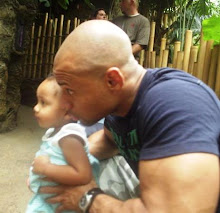
(By the way, a wise man once told me to NEVER trust a big booty and a smile. I wholeheartedly trust that advice. You should too.) So I've compiled a list of rules that will put you on the path to building fantastic biceps and triceps so that you can wear your skin one size too small and start getting some of that well-deserved attention.
1. Keep your elbows in. This is HUGE. No matter if you're training biceps or triceps, refrain from allowing your elbows to stick out. For example, while performing standing dumbbell curls, instead of letting your elbows move laterally away from your body as you lift the weight, keep them "glued" to your sides. This allows for better isolation of the biceps due to the strictness of the movement. The same principles apply for all triceps exercises as well.
2. Don't swing or use momentum to lift the weight. This sort of goes hand-in-hand with the tucked elbows rule. How many times have you ever seen the guy in the gym attempting to do heavy barbell curls by swinging his hips forward to give the weight a jumpstart upward? It's as if he's trying to hump the bar! If you've never seen that guy, then you've either never been to a gym or you ARE that guy. Don't be that guy. As said before, strict movements will make for better isolation for the specific muscle or muscle groups that you're trying to emphasize. Remember, it's all about quality, not quantity.
3. Use a full range of motion. This is another common mistake that I see from novice lifters and gym "experts" alike. Stay strict and move the weight with a full range of motion with full extension and full flexion at the elbows. Frankly, this rule should actually be applied to ALL exercises.
4. Build your biceps/triceps training routine around heavy barbell curls and close-grip bench presses. These two exercises should be the meat and potatoes of your arms training. Everything else is just details. Barbell curls should always be performed with a straight bar, and NOT an cambered bar. Straight bars allow for a better, harder contraction of the biceps during full flexion due to the fixed supinated (palms up) hand positioning it forces. Cambered bars put the hands in a near half-supinated position which decreases the stress placed upon the biceps during elbow flexion. Close-grip bench presses are, without question, the backbone exercise for great triceps development. Grip the bar with about 6 to 8 inches between your hands, and remember rule number one--keep your elbows in. Once your elbows move outward, you begin to place more stress on your pecs and less on your triceps. Keep 'em in, and watch your tris blow up! Close-grip bench presses (along with dips) are also one of the best exercises for increasing your bench press one-rep max. And, like always, train heavy.
5. Emphasize triceps over biceps. Another common mistake. All anyone wants to do is bench press and do curls for the girls, because they think that huge biceps are the cornerstone of great arms. But they've got it backwards. If you want some decent guns you've gotta hit the triceps first and foremost. It's common sense, guys: Your triceps take up two-thirds of your upper arms. Just break down the words 'triceps' and 'biceps'. Tri- means three, meaning your triceps have three heads. Meanwhile, bi- means two, meaning your biceps have two heads. Simple mathematics...don't neglect your triceps. Train them first.
These five quick and easy tips for upper arm development will quickly get you moving in the right direction towards turning a few heads and raising a few eyebrows.
Now, what are you going to do?
CAS
